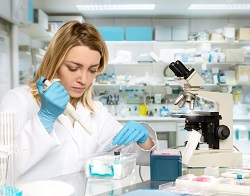From thesis to synthesis: Potential anti-cancer compounds from natural products
Of all the new chemical entities approved for oncology to date, more than half are natural products or related molecules. New natural products and their derivatives have potential but their development to the clinic is often limited by poor bioavailability, toxicity and an inability to access sufficient quantities of material. OXIOSCR: training for the future The EU-funded OXIOSCR(opens in new window) project has successfully trained graduate organic chemists to optimise synthetic routes to natural products with anti-cancer activity. As Professor Jeremy Robertson explains ‘OXIOSCR was primarily a synthetic chemistry training programme that aimed to lower barriers against adoption by mainstream synthetic chemists of anything out of the ordinary.’ OXIOSCR merged an innovative training programme of lectures, seminars and short courses in advanced analytical and synthetic methods and medicinal chemistry. Activities designed to inspire, guide and encourage appreciation of the potential of each area were explored in a series of awareness events. In collaboration with associated partners and guest academics, early stage researchers (ESRs) participated in the areas of biocatalysis for sustainability, flow chemistry, electrochemical synthesis, and computation and chemoinformatics. New molecules make their debut Tumour cells have a high level of anti-apoptotic proteins, such as Bcl-2, that interfere with normal cell death and are associated with cancer cell progression and resistance to chemotherapy. The OXIOSCR team successfully synthesised aruncin B, a Bcl-2 inhibitor, and the core of a chemically and biologically unique modulator of Bcl-2, incednine, a bacterial metabolite. Other promising compounds include inthomycin C, a natural antitumour product that was incorporated into the flow towards a total synthesis of oxazolomycin B, an antibiotic. Moreover, six lead molecules of the ethisolide class were prepared with potential against immune system diseases, and originally isolated from fungi. Significant new synthetic methodologies The ESRs produced many new synthetic systems that will help other chemists make a variety of molecules. Prof. Robertson highlights the innovations that the OXIOSCR training provoked. ‘Successful coupling of electrosynthesis and flow chemistry has produced an electrochemical flow cell in collaboration with IMB-CNM(opens in new window); a paper on this is in advanced draft form for submission very soon. Additionally, one ESR used electrochemistry to effect reactions that had only been previously achieved with a metal-based oxidant.’ For testing a selection of around 1 500 molecules synthesised, the team adopted a multi-faceted collaborative approach including high content imaging, combined cell viability / mechanism-based bioassay, and computationally-predicted activities. Having whittled down the number of possible molecules to just over 100, a virtual library of diverse compounds with interesting activity is available for applications in cancer chemotherapy. Synthetic chemistry pathways reach their destination and beyond Altogether, the project anticipates around 30 significant research papers. The ESRs have presented their work as 128 oral and poster contributions at conferences globally. Eleven of the thirteen ESRs have submitted their thesis, seven of whom have so far successfully achieved their doctorates. The barometer of success of the OXIOSCR project is multi-pronged. Already, five ESRs have positions in academic or industrial research and some are almost ready to embark upon independent academic careers. In another aspect, the Synthesis for Biology and Medicine Centre for Doctoral Training at Oxford modelled some elements of their programme on OXIOSCR. Prof. Robertson sums up the success and the philosophy of the project. ‘OXIOSCR was intended to be a model example of a doctoral programme that would inspire others to form multinational networks. I expect that the ESRs were stimulated by their involvement in the programme and that the ideas conveyed will influence their decisions during their subsequent careers.’







